When we hear the word “eel”, we usually imagine a snake-shaped fish of a greenish-gray color. Our first association is a freshwater eel. Then the electric eel inhabiting the ponds of South America comes to our minds. By the way, this so-called eel has nothing to do with real eels, except for resemblance of their body shape. They belong to completely different fish orders. Occasionally, the conger eel occurs to us. Perhaps, this is all we can think of. And it’s no good.
The Anguilliformes order includes 20 families, 111 genera and about 800 species. If a little more than two hundred species of existing representatives of the Muraenidae family are removed from the list, still there are about six hundred species of “eels” inhabiting the waters of the planet.
The smallest representative of the order is the Monognathus Ahlstrom eel, discovered in the 1970s about 2,000 meters deep down. Its maximum length is only 5 centimeters, and it inhabits the Pacific Ocean near the California coast. The largest eel is a European conger (Conger conger), which grows up to 3 meters long and can weigh up to 110 kilograms.
adriaticnature described in detail the life cycle of eels in the article about moray eels, but the following picture depicts it more clearly:
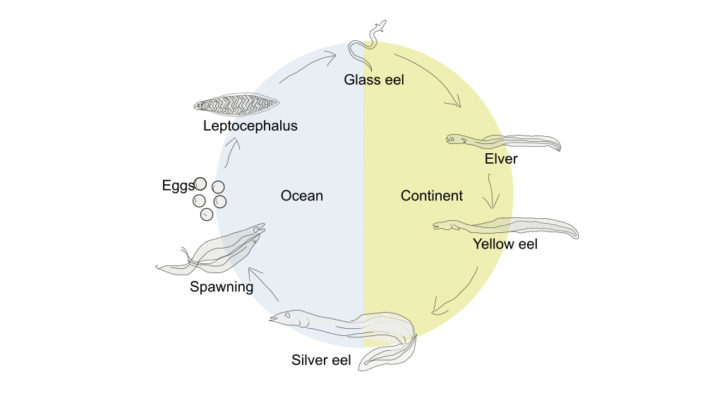
(Eel Life Cycle: Picture © Salvor Gissurardottir, en.wikipedia.org)
Eels have no pelvic fins, and some species don’t have pectoral fins. The dorsal and anal fins merged with the tail fin, forming a single “strip” that runs along most of the body length of the fish.
Most eels inhabit the shallow part of the sea, but there are species that prefer depths of up to 4,000 meters. Most of the eels prefer a night lifestyle, during the day they dig themselves into mud, sand or hide in crevices of rocks. That’s why it’s not so easy to find them. Bene qui latuit, bene vixit – the one who hid well, lived well – is the Latin catchphrase, which is a quotation from the elegy by Publius Ovidius Naso.
Except for the fish belonging to the Anguilla genus (there are slightly more than twenty species, and the most well-known is the European eel (Anguilla anguilla), the only species of the genus that occurs in the Adriatic and freshwater bodies of the Adriatic countries), all eels are inhabitants of the sea waters.
There are 16 representatives of the Anguilliformes order in the Adriatic Sea. adriaticnature shared information on spiny eels and moray eels in previous articles. Now, it’s time to deal with the rest in species “alphabetical order”.
Bicolor eel (Chlopsis bicolor) is a rare inhabitant of the Adriatic. According to scientists, this eel is rarely seen both in the Mediterranean and in the coastal waters of the eastern and western Atlantic, where it occurs at depths of 80 to 365 meters. It spends most of the time being dug in the mud. It feeds on medium-sized crustaceans, hunting for them mainly at night. It can be up to 42 centimeters long.
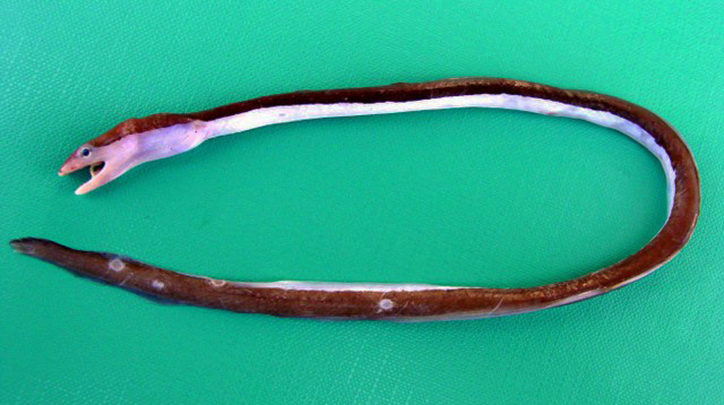
(Bicolor eel. Photo by © Pierpaolo Consoli. fishbase.org)
Bandtooth conger (Ariosoma balearicum) is a small eel, inhabiting the depths of up to 730 meters, more often it can be found in the range of 20-100 meters deep down. It grows up to 35 centimeters long, but an average specimen is up to 25 centimeters long. It spends most of the time in holes being dug in the sandy bottom, feeding on crustaceans and small fish mainly at night. It is quite a rare inhabitant of the southern part of the Adriatic Sea.
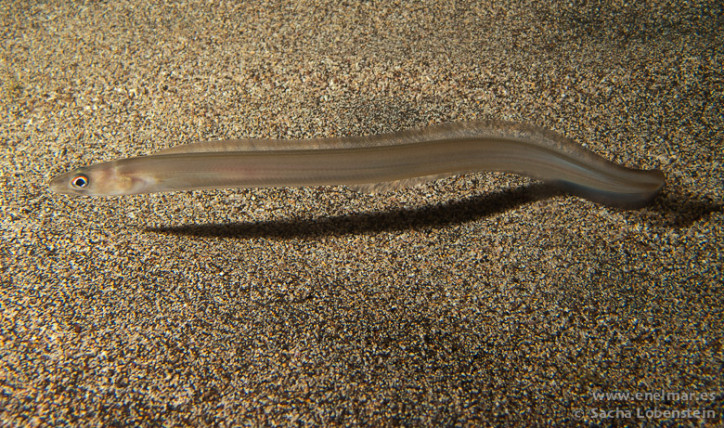
(Bandtooth conger. Photo by © Sacha Lobenstein. enelmar.es)
European conger (Conger conger) is one of the most common eels in the Adriatic. Conger is the largest representative of the Anguilliformes order, growing up to 3 meters long and weighing up to 110 kilograms. The size and the way this fish looks are really impressive.
The way the congers act is similar to moray eels. They hide during the day among the stones or in caves, sometimes together with moray eels. They leave their shelters at night to hunt. They feed on fish, cephalopods and crustaceans, they even don’t mind eating carrion.
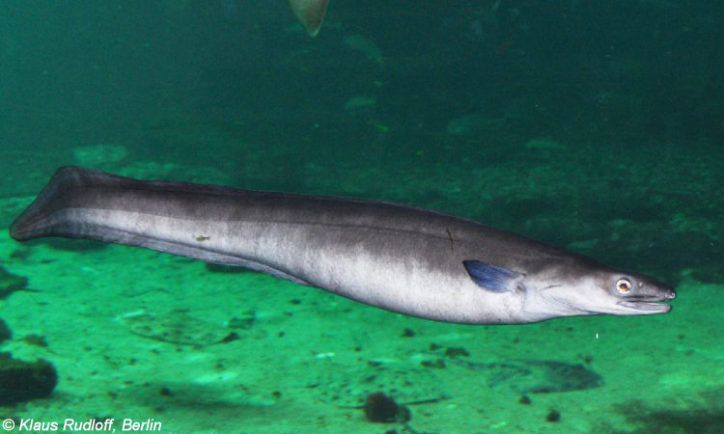
(European conger. Photo by © Klaus Rudloff. biolib.cz)
Congers usually inhabit the depths of up to 500 meters, but they can reach a depth of 3,600 meters during migrations. They can be found both in shallow water and at depths of up to 1,170 meters. Young congers live near a stony, broken bottom near the shore, moving to deeper areas with aging.
Congers spawns in the Mediterranean Sea and the Atlantic Ocean. Females shed up to several million eggs at depths of 2,000-3,000 meters, reproducing once in a lifetime, like other representatives of the order.
One should treat the conger caught with a fishing gear with caution, since it has sharp teeth and strong jaws, along with a muscular body.
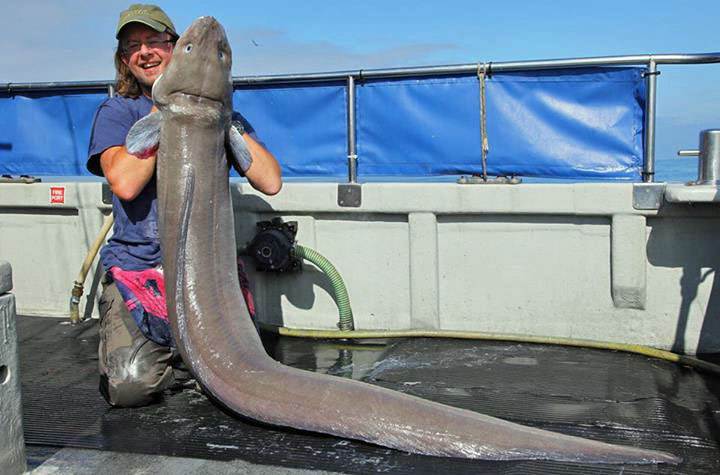
(Conger weighing 43 kg, caught by Martin Bowler. Photo © planetseafishing.com)
Thinlip conger (Gnathophis mystax) is a constant rare inhabitant of the southern part of the Adriatic Sea. It is even less common in the middle and northern part of the Adriatic. Like most representatives of the Anguilliformes order, during the day it hides in mud or sand and goes hunting in the twilight. It inhabits the depths of 75-800 meters, feeds on crustaceans and small fish. Specimens up to 35 centimeters long are more common, but they can be up to 60 centimeters long as well.

(Thinlip conger. Photo by © Jo Langeneck. it.wikipedia.org)
Facciola’s sorcerer (Facciolella oxyrhyncha) is an extremely rare visitor of the Adriatic Sea. This inhabitant of the eastern Atlantic Ocean, including the waters of southern Portugal, Angola, as well as the Ligurian and Tyrrhenian seas, has recently been found in other parts of the Mediterranean Sea more often. It was reported that Facciolella oxyrhyncha occurred in the southern part of the Adriatic. The eels often hide in caves, located at depths of 30 to 730 meters. It hunts for crustaceans at night. It grows up to 65 centimeters long.
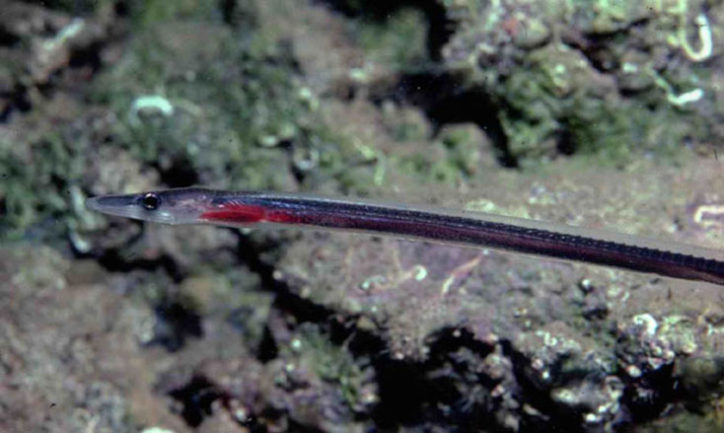
(Facciola’s sorcerer. Photo by © Dr. Peter Wirtz. fishbase.org)
Blackfin sorcerer (Nettastoma melanurum) is more common near the Ionian Sea and is very rare in the Adriatic in general. It inhabits the depths of 330 to 860 meters, however, it was found at the depths of 40 to 1,650 meters. It feeds on crustaceans and small fish, growing up to 77 centimeters long. It hunts at night and digs itself into the muddy bottom during the day.
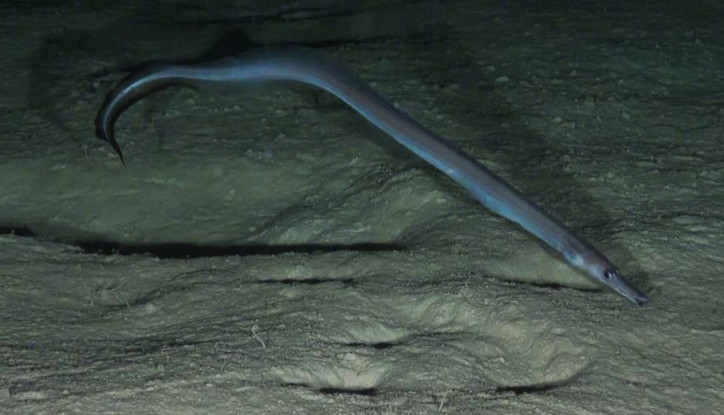
(Blackfin sorcerer. Photo by © OCEANA. flickr.com/photos/oceanaeurope)
Slender finless eel (Apterichtus anguiformis) is a rare guest of the Adriatic Sea. It hunts at night and digs itself into sandy or muddy bottom at depths of 10 to 250 meters. This species is barely studied. There were few recorded occurrences. The maximum length of this eel is 49 centimeters.

(Slender finless eel. Picture by © colapesce.it)
European finless eel (Apterichtus caecus) is found quite rarely as well. Nevertheless, it’s a permanent inhabitant of the Adriatic Sea. During the day, it hides in holes in the sandy bottom, at night it hunts for crustaceans and small fish. It inhabits the depths of up to 85 meters. It grows up to 60 centimeters long.
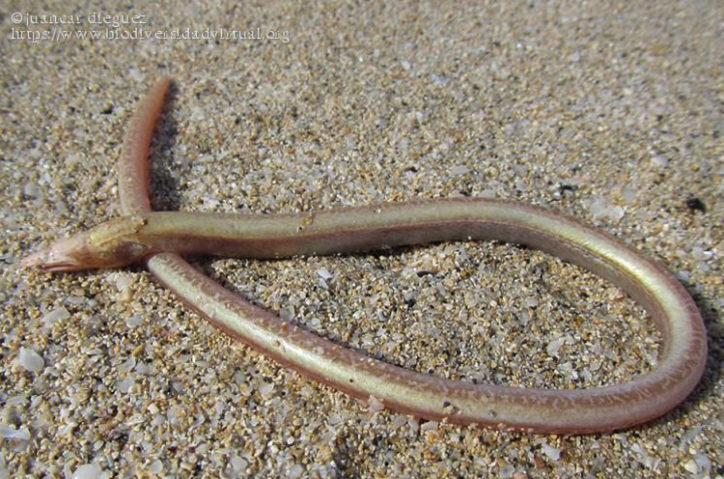
(European finless eel. Photo by © Juancar Dieguez. biodiversidadvirtual.org)
Armless snake eel (Dalophis imberbis) is another constant infrequent inhabitant of the Adriatic. It inhabits the depths of 20 to 80 meters, digging itself into the sand or mud during the day. It feeds on crustaceans and small fish. It grows up to one and a half meters long. This species is still barely studied.
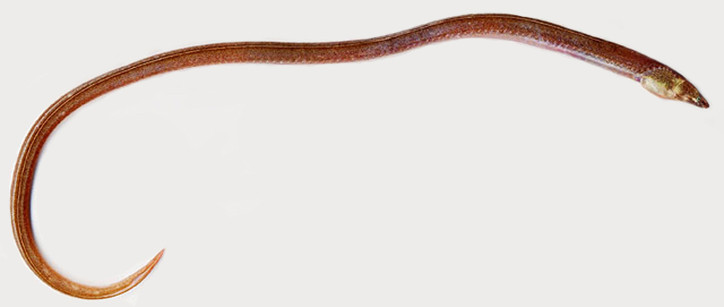
(Armless snake eel. Photo by © José Manuel Blanco Moreno. fishbase.org)
Painted eel (Echelus myrus) is more common in the southern part of the Adriatic Sea. It inhabits the depths of 3 to 1,490 meters. During the day, it digs itself into a muddy or sandy bottom. It hunts for crustaceans, mollusks and small fish. It grows up to one meter long. Specimens up to 60 cm long are more common. It feeds on crustaceans, mollusks and fish.
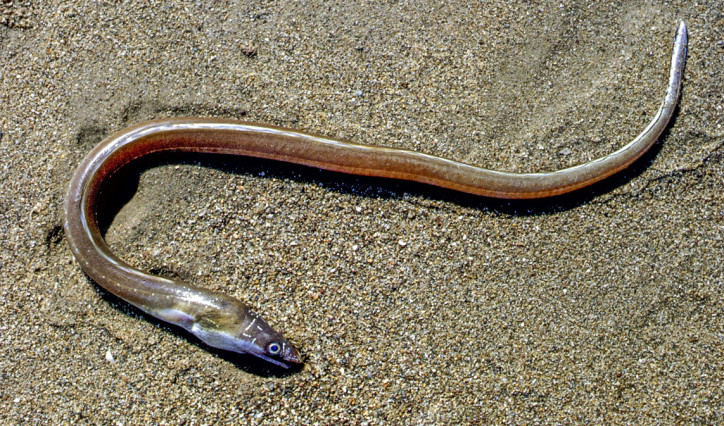
(Painted eel. Photo by © greekwildlife.gr)
Rufus snake-eel (Ophichthus rufus) is the Mediterranean endemic that prefers nightlife. During the day, it hides in holes in the muddy bottom and hunts for benthic invertebrates and small fish in the twilight. It inhabits the depths of 40 to 660 meters. It frequently occurs in the Adriatic but can be seen quite rarely due to its habit of hiding. It grows up to 60 centimeters long.
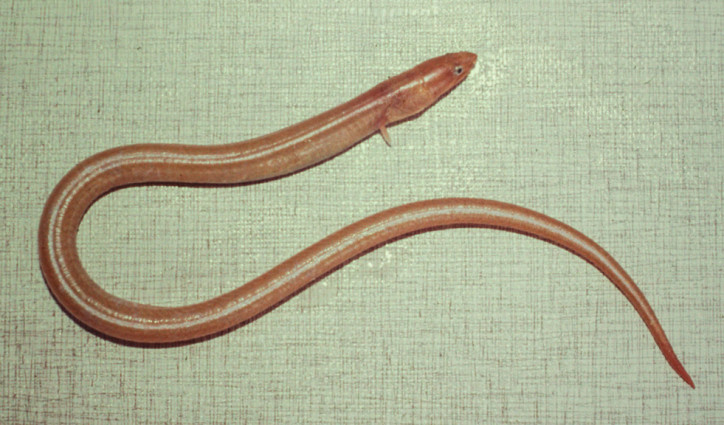
(Rufus snake-eel. Photo by © greekwildlife.gr)
Serpent eel (Ophisurus serpens) is a constant infrequent inhabitant of the Adriatic. Like most representatives of the Anguilliformes order. It prefers night life, digging itself into the sand or muddy bottom during the day. It is a large eel, growing up to 2.5 meters long, feeds on small fish, mollusks and crustaceans. Specimens up to 1.5 meters long are more common. It inhabits the depths of up to 300 meters and sometimes enters the mouth of rivers.
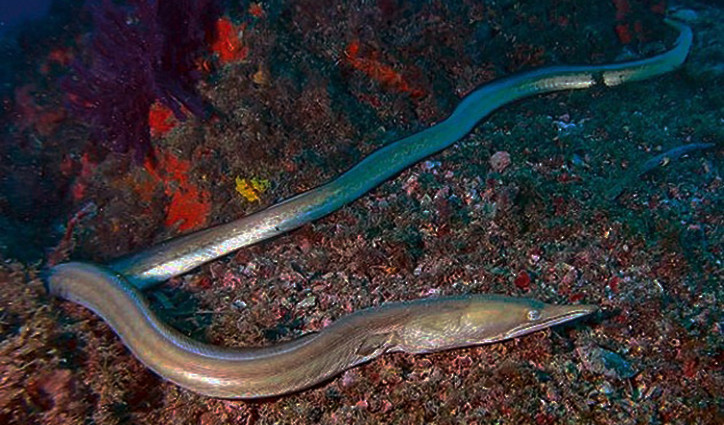
(Serpent eel. Photo by © slobodnadalmacija.com)
adriaticnature will provide detailed information concerning the last representative of the Anguilliformes order – European eel (Anguilla anguilla) – in the section dealing with the freshwater inhabitants of the Balkans and the Apennine peninsula.